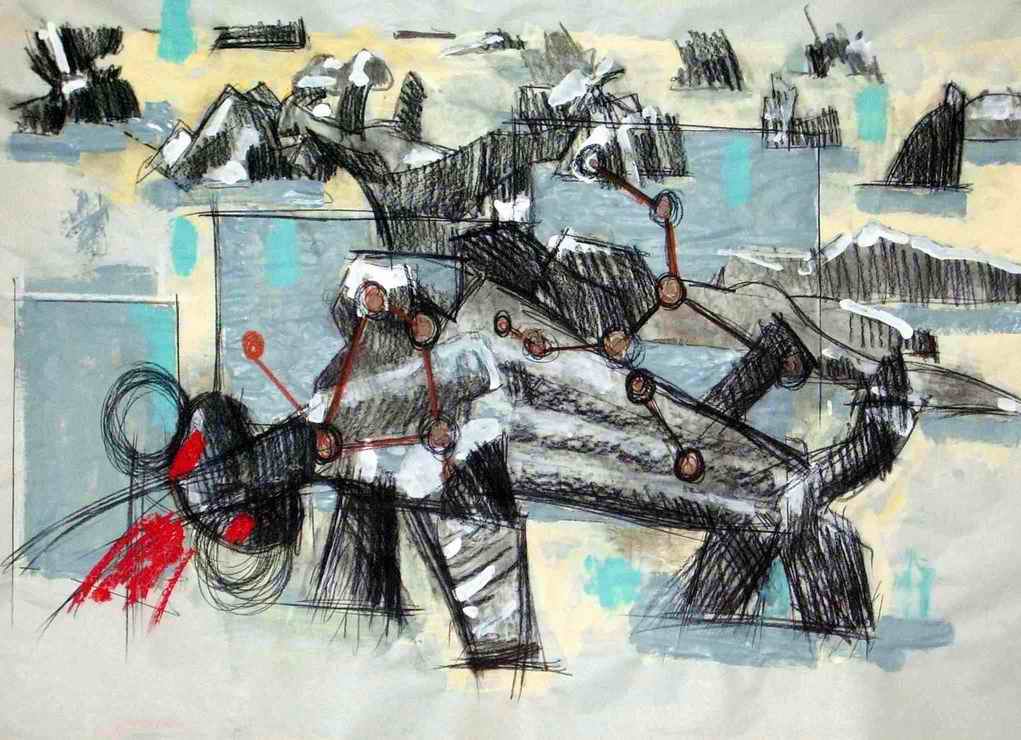 F
14
F
14
ANGELO EVELYN'S WORKS INSPIRED BY THE EICHSTAETT FIGURENFELD
|
The works shown here have the strength and spontaneity of Angelo's early Canadian and Norwegian sketches. They are charcoal and acrylic, on newsprint paper, 100 x 180 cm. Angelo thinks they are pretty abstract though of course the landscape of the Eichstaett figurenfeld site comes across clearly. As for the sculptures placed into this landscape by Wuensche-Mitterecker, the artist says he wanted them to appear in these works as something immovable, as if they are rocks growing out of the earth. There are several layers in the works in question. Certainly the landscape, then the rock-like figures (representing the sculptures, but not recognizable as such, in some instances), and laid above all of this, the "star constellations." "I shuffle them at random," the artist noted, it's "kind of mixing earth and the sky": "something coming out of the earth and being projected into the sky."
|
 F
14
F
14
| The work shown here (F14) "borrows" a shape, shown in the foreground,
that was originally chosen by the Eichstaett-based artist. But it is even
less of a human form than the sculpture which served as a 'Vorwand' (or
inspiration). Something like blood, indicated "abstractly," seems to spill
from the form, from what may be its "head." Some shapes are like propellers
of ships, or approaching the shape of crosses hewn out of a stone
cube. (See the form in the upper left corner!) The distribution and
size of the objects suggests a considerable depth of the space represented.
The star constellation somehow is like the horizontally deposed skeleton
of the dead body represented by the sculpture-like shape. The abstraction,
in this way, is carried even further.
|

F17
| A uniformity, a universal harmony, or rather, an equality, is
achieved here. It is the equality of the dead. It is a fathomless tristesse.
There are the reminding sculptures. Frozen into concrete, they are the
remains of memory, the traces left by the artist who remembered, who created
the Figurenfeld or "field of figures."
In their pastel color, a color approaching a pale violet, with traces of green and blue mixed into it, they are the rocklike counterpoint of the bushes, represented by a turquoise green. A wall, all turquoise green, is limiting the scene, creating a strong barrier. Above it hover two threatening black patches, two clouds, the artist says. Ominous clouds. In them appear the stars of the night that covered the scene of death, and buried the dying. I see lightnings flashing. But is "only" the starry constellation imagined. I see a face appearing threateningly in the left cloud. But it is no punishing god. No demon. No image of a dead soldier watching the site of his death from on high. It is only the constellation of stars half hid in the cloud, the menacing dark cloud of night. The comforting dark cloud. (This work is not on newsprint paper but "on good paper.")
|

F 2
| A very painterly work, and yet, we see the strength of the charcoal
drawing.The two "media" (a tender pastel ochre; the strong black of the
charcoal) contrast and relate beautifully. A certain coarseness of the
charcoal traces suggests the quality of rock surfaces.
Indeed the sculptures, so much land art already in Wuensche-Mitterecker's ensemble, have been turned even more so, into a facet of nature. |

F 3
| In the next work (F3) the pieces of stone that form the sculpture suggest
not only rocks but a fossile, a strange being transformed into stone by
the ages. To Angelo, what he has seen is a centaur. And he has superimposed
that star constellation, Centaurus.
Views of the landscape are inserted. The work is using frames within the frame, lines that suggest an open space. The complex including the star constellation is set apart, juxtaposed not superimposed, with reference to the larger (lefthand) "figure" but it is also partially superimposed across a small (righthand) figure. The tensions between the diverse elements are clearly felt. In view of the lines and frames within the frame, the impression of a sketch or architectural drawing is enhanced. |

F 6
| Here (in F 6) the summer landscape seems to "meet" or confront, that
is contrast with, the same landscape visited in winter. As indeed the artist
saw the figurenfeld both in summer, on a hot sunny day, and in winter while
snow scovered the sculptures.
The juniper and other brushlike phenomena remind us of Italian landscapes, of cypress trees in the Toskana, for example. The character of the Eichstaett landscape is captured with great precision. But the small trees or bushes might also be large leaves, of a tree sketched in fleeting, almost impressionist style. The shady leaves of the tree, the greenery seems to hover or to be suspended above the scene. The figure, the bridge-like stone, is like a human being, not flattened yet on the ground but bending backwards, its back curved, in agony. |

F 8
| Raw, mechanical pieces, scattered across the land. Here, they could
be made of iron. They are condensed, the density of their concentration
wipes out much of the ground left inbetween them in the original site.
Angelo Evelyn works with transformations, rather than "reproducing" what he has seen. Art works with transformations, good art, at least. At a distance, in the background, the spaces between one object and the next get larger, and the objects now do not appear to be "figures" but brush, small trees, in other words, plants. Something alive not man-made. Something green and growing and withering in dry autumns, not stone that seems almost eternal and gives way only slowly to the forces of erosion. We discover the star constellation of Cetus. If we wouldn't know, the handwriting of the artist would tell us so.
|
- Andreas Weiland (Jan. 10, 2005)